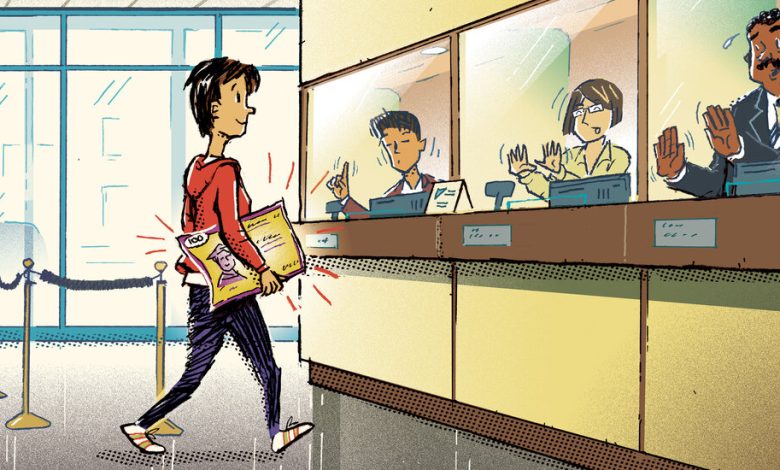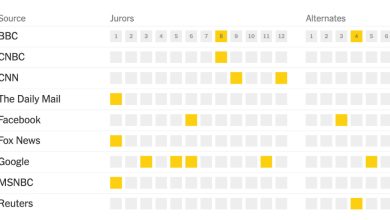When Did Cashing Savings Bonds Become So Impossible?

Hoping to cash in a paper savings bond that’s been lying around for a few decades? Set aside a lot of time for disappointment.
Those government-backed slips, doled out by generations of well-meaning grandparents to children expecting more exciting gifts, were long thought to be as good as cash. Shaped like dollar bills, savings bonds promise recipients a lucrative lesson in the value of prudence: The longer you keep them, the more interest they accrue and the more they will be worth when you finally cash them.
Of course it doesn’t matter how much something is theoretically worth if you can’t exchange it for money. And in the case of savings bonds, trying to do so increasingly results in a journey into a world of colliding, inconsistently enforced bank policies.
Like all bonds, savings bonds are essentially a loan, in this case, to the federal government. Though the paper slips may be labeled $100, they cost the purchaser only $50. The higher face value includes interest the loan accrues over years, which generally doubles the value of the bond over two decades and allows the holder to be paid out at the higher sum.
If this sounds simple, it should be, but since you’re lending to the U.S. government, the last step gets tricky. You can’t just waltz into any government building and demand your money. (Until 1977, post offices sold bonds, but never redeemed them.) You can either send your savings bonds to the Treasury — more on that later — or try cashing them at a bank.
The fine print on the back of savings bonds usually reads, “payable by any financial institution.” Hence, any bank should do.
Banks, however, are merely an intermediary, so this is true only in theory. If they agree to exchange the bond for cash, they are essentially fronting money for a piece of paper that they then have to chase after the government for.
Many, like Capital One and USAA, which caters to military families, simply won’t cash savings bonds for anyone. A Capital One spokeswoman cited “limited consumer demand.” Other banks reject the bonds, citing policies they don’t actually hold or are incorrectly applied, or offering reasons that are the equivalent of “sorry, we just don’t feel like it.”
Depositors who have tried cashing savings bonds at banks recently have been inundated with questions, they said. How long have you been a bank client? How much are looking to cash out? Are you willing to put a hold on your account until the funds clear? Have you ever changed your name — and why?
“Everyone thinks that bonds are like cash — well, not anymore,” said Pam Dubier, a 62-year-old San Francisco real estate broker who underwent a four-month odyssey this year to help her retired mother cash her savings bonds.
The process is only getting harder. In May, the nation’s largest bank, JPMorgan Chase, began imposing a $500 limit on each savings bond cashed for longtime depositors — that’s total redemption value, so including any interest owed. Wells Fargo and Citi place a $1,000 limit on new customers. U.S. Bank has a five-year waiting period before it will cash a bond for a new customer.
No bank will accept savings bonds via electronic deposit, as they do with nearly all personal checks.
If you haven’t heard of any of this, you’re not alone. Few banks post their savings bond policies publicly, and all allow themselves wiggle room to bend their own rules. Colin Wright, a Citi spokesman, said that while Citi would theoretically cash any sum for a longtime depositor, “it’s hard to say that in every instance we would do it.” Asked why, he said the decision would be based on “a number of other factors.”
When this reporter, a Chase client with four of the bank’s credit cards and a three-year-old Chase business account, went to his local branch with paper bonds, the teller disappeared for about 10 minutes before returning with the news that Chase would not cash any of them. The stated reason: Chase couldn’t vouch for his trustworthiness and was scared the bonds might be fraudulent. (A spokesman later said that the teller was mistaken.)
Robin Potter, 59, said that her longtime bank, Wells Fargo, rejected her when she went into a Yardley, Pa., branch to redeem around $4,000 of decades-old savings bonds. She followed up with a call to the bank’s national hotline and was told again that they don’t cash savings bonds.
A Wells Fargo spokesman said that was incorrect, but there was no way for Ms. Potter to know that. The bank doesn’t post its savings bond rules publicly.
Olivia McGann, 33, was rejected by M&T Bank this summer while trying to cash a $50 savings bond she had received at birth from her aunt. The teller at Ms. McGann’s Buffalo-area branch said her name didn’t match the one on her savings bond — and wouldn’t accept the legal name change paperwork that Ms. McGann, who is transgender, brought as proof.
An M&T spokesman said the only permitted name changes were those due to marriage.
“I want the money,” Ms. McGann said. “It’s a giant pain.”
Savings bonds used to be much easier to cash. When they were introduced at the height of the Great Depression as a way to fund the war effort, they were said to be as good as gold — literally. The Treasury Department crowed that they were replacing gold pieces as holiday presents.
Decades of government-funded television spots, starring figures as varied as John Wayne, Bugs Bunny and the cast of “Cheers,” advertised the bonds as a matter of patriotism. “Buy your share of freedom today,” exhorted the Looney Tunes star in one advertisement, under the slogan “Take stock in America.” Bonds were then sold and cashed at the Treasury Department and Federal Reserve Banks — none of which is possible anymore.
One factor that has changed, say bank and government representatives, is fraud. Representatives of various banks cited fears of cashing fraudulent bonds, but wouldn’t say how common it was or whether they had tried other means to combat it. Matthew Garber, a spokesman for the Treasury Department’s Bureau of Fiscal Service, declined to answer questions, writing in a statement that the organization in early 2022 “updated our guidance to give banks additional flexibilities when considering whether they should redeem a paper U.S. savings bond presented at the counter.”
Mr. Garber wouldn’t say what the prior guidance was. The current Treasury Department instructions tell banks to cash bonds for “an established account holder at your bank who presents the proper identification and who seems worthy of your trust.”
More than 80 percent of savings bonds are cashed at bank branches, Mr. Garber wrote.
What about the rest? As of the end of July, $68 billion of savings bonds were in circulation, according to federal statistics. Nearly half, or $32 billion, are so old they are no longer accruing interest, meaning they are now an interest-free loan from the citizenry to the government.
Outside of taking your chances at a bank, the only other option to cash out bonds is to send them to the Treasury — and that, as Ms. Dubier, the real estate broker, found out, involves a good deal of faith.
In February Ms. Dubier discovered nearly $300,000 in savings bonds stashed in a Tupperware container belonging to her mother who was in hospice care. Her brother printed out a Treasury Department’s claim form, filled it out, got his signature certified and sent it in via certified mail.
It was rejected several times, first for lacking a power of attorney document (the family sent that in 24 hours later), then as they waited for the Treasury Department to fix troubles with the wire instructions. The family was told that this could not be resolved via phone call or email — they had to wait for the Treasury Department to reach out to them.
It took five months for the funds to arrive. “We are very glad that we didn’t urgently need the money,” Ms. Dubier said.



